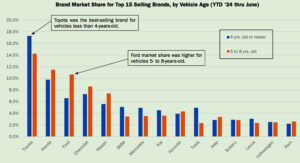While there is some disagreement on the number and growth of unsold EVs, for many EV models, supply has overtaken demand
Fort Wayne, Ind.—While electric vehicle sales are climbing in the U.S., there is growing evidence that EVs are not doing as well as expected and that sales could be reaching a point of unsustainable growth as the pool dwindles of potential buyers who are EV enthusiasts.
The change from Internal Combustion Engine (ICE) to EV is primarily a top-down project, argues Lang Marketing in a recent analysis, stating that the U.S. government is pushing for replacing ICE vehicles with EVs — not “based on a groundswell of consumer demand, but about what consumers should do.”
Moving away from ICE vehicles involves changes in automotive battery technology, new manufacturing techniques, a nationwide vehicle-charging network, and an unmeasured increase in electricity use that will place more demands on the country’s electrical grid.
Five signs point to challenges for the rapid growth of EVs on U.S. roads, according to Lang: escalating dealer inventories of unsold EVs, new EV price cutting, spotty resale value of used EVs, an untested secondary market for EVs, and lower projections of EV sales.
The following is Lang’s breakdown:
Growing Dealer Stocks
Unsold EVs are building on dealer lots. While there is some disagreement on the number and growth of unsold EVs, for many EV models, supply has overtaken demand.
Many new EV models will reach dealers’ showrooms over the next 18 months, requiring an increased demand to avoid oversupply. The report adds that present demand is not keeping pace with growing shipments of EVs to dealers.
Price Cutting
To increase consumer demand, some automakers, notably Tesla, are cutting the prices of EVs, whose costs are higher on average than comparable ICE models. While this might be effective in the short run, it is discouraging to many EV owners who have seen their recently purchased EVs decrease in value due to price cuts.
Lower Resale Value
While price cutting has eroded the value of used EVs, other concerns — such as the advancing technology of newer EVs and customer concerns with range and safety issues — have led to many EVs depreciating faster than comparable ICE models, Lang states, adding that this has implications for the attractiveness of new EVs to potential buyers at a time when many new EV models are set to enter dealer showrooms.
Vehicle Ownership Cycle
Most cars and light trucks on U.S. roads are driven by secondary owners. The average car and light truck passes through the hands of multiple owners before it is scrapped.
The reasons that customers buy previously owned vehicles can vary dramatically from why they buy new ones. The financial condition of many used car buyers is significantly different from that of new buyers. These two groups also can differ in their vehicle needs and uses.
Those and other issues, which are starting to emerge in the EV market, could signal challenges for EVs to satisfy in the secondary-buyer market, representing over three-quarters of the cars and light trucks on U.S. roads.
Reduced Sales Projections
Many car manufacturers and industry analysts are lowering their projections of how the new EV market will develop by 2030.
Last year, it was not uncommon for analysts to expect that by 2030, EVs would capture two-thirds of new car and light truck sales in the U.S. Today, many such projections have decreased to 35% or lower, according to Lang. Even if EV sales reach 35% of new car and light truck volume by 2030, their impact on the VIO and aftermarket product sales will remain limited for a number of years beyond.





Comments are closed.